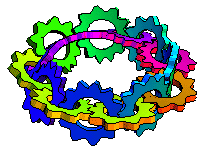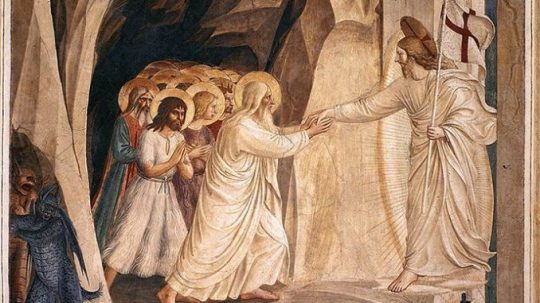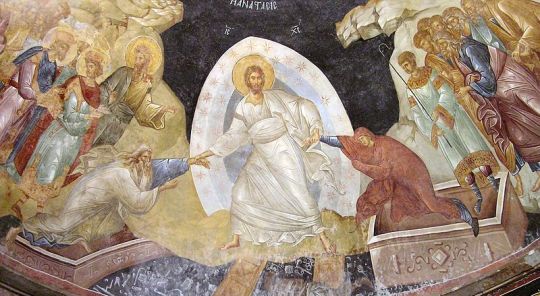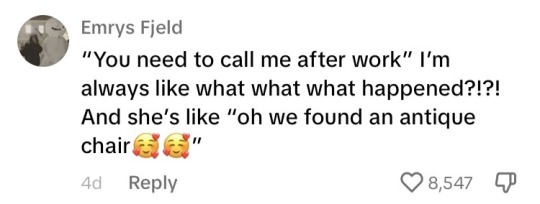Name, raspomme. Kagerou Project, Shuuen no Shiori Project, Pandora VOXX, utaite, anime, cute things. English, 日本語, 中文 ok です About me Song covers YouTube Twitter How to ask permission Please read before sending asks Permission FAQs Friends & Family bg by abekemalu
Last active 60 minutes ago
Don't wanna be here? Send us removal request.
Text
Someone on Amtrak’s social media team deserves a raise like N O W. 😂
10K notes
·
View notes
Text
Today's Seal Is: Making Contact With An Unknown Beast
104K notes
·
View notes
Photo

http://mathworld.wolfram.com/MoebiusStrip.html
Two interlacing Moebius strips made of gears.
30K notes
·
View notes
Text
Today's Walrus Is: Mysterious Ronin

31K notes
·
View notes
Text
reading nabokov is maddening because his writing is so playful and evocative and effortless and english isn't even his first language. he's doing things in a second language most people could spend their lives trying and failing to replicate in their first language. makes me feel like this

45K notes
·
View notes
Text
sometimes you'll see a bird for the first time and when you look it up you learn that its name is the Common Dirt Bitch and its range is Everywhere and there are 400 million of them in your state alone
28K notes
·
View notes
Text
Inspired by this post by @thanergetic-hyperlinks, I present to you
Tessellations of the Nine Houses
(Or "I can't really draw figurative art so my Locked Tomb fanarts are geometrical vector drawings")
"A tessellation or tiling is the covering of a surface, often a plane, using one or more geometric shapes, called tiles, with no overlaps and no gaps." — Wikipedia.
Making tilings themed after each necromantic House seems obvious: for each House you pick a tile with the same number of sides as the number of the House; but this does present some challenges for some of the Houses.
note 1: this might give the impression that I first decided on the symbols and then found patterns to match them in a very organized and motivated manner; in practice it was much more chaotic and multidirectional, the patterns informing the symbols as much as the symbols informed the patterns; this is fine since symbolism is entirely associative and arbitrary anyway
note 2: I added alt-texts for all the images, but I have no idea of how to properly describe abstract geometric art; if you feel you can do a better job than I did, feel free to put your fingers where your mouth is--wait, hang on-- I mean feel free to provide better descriptions if you can
note 3: looking forward to the geometry nerds explaining to me how I got basic geometric details wrong, friggin nerds
The First House
The First House seems obvious, as a shape with one side is an ellipse (of which the circle is a special case). There's just one problem: ellipses do not tile the plane. No matter how much you stretch them and deform them, the very nature of ellipses means you'll always have gaps or overlaps.
So we cheat and we work with overlaps: turns out there is a history of tiling that use circles as a construction pattern, then turning the overlapping sections into the actual tiles. Such patterns have been used extensively in European and Middle Eastern art, and have also been associated with the New Age movement, so it fits Jod's style perfectly. And so we get this:

The different cells correspond to different House colors, with the resulting gothic stained-glass appearance quite in line with the Roman Catholic Empire vibe Jod is going for. The overlapping circles convey the intricacy of the relation between the first House and the nine other, both autonomous from it yet intrinsically part of it.
The Second House
There's a variety of geometrical shapes that have two sides, but most of them don't tile the plane, altho there is one that does — if we take a crescent shape and slightly thicken it so that the inner and outer curves are identical, we can do this:

The waving pattern is of course evocative of the flag of conquest which the Cohorts of the Second House have planted on many worlds.
The Third House
With the Third House things get a lot easier, because equilateral triangles are one of the three regular polygons (where all sides are the same length and all angles are identical) that tile the plane all by themselves without needing any other shape! Which however doesn't mean we have to be boring, we can have a little bit of fun:

Flowers for the beauty and ionizing radiation warning signs for the rancid vibes.
The Fourth House
Squares are the second regular polygons that tile the plane by themselves, so again our job is easy here, altho we still want to not go for the easiest option in order to be able to work in some symbolism:

The four big navy squares with a small white square at the center of course evoke the number five and the shadow of the Fifth House's regency over the Fourth.
The Fifth House
Regular pentagons do not tile the plane, so we have to use a more unusual shape — there are many options, but obviously we want to again pick one that offers some interesting numerical symbolism:

The cross-like patterns of course bring up the number four and the hold of the Fifth House over the Fourth. As for the crosses themselves and the fact that they appear to be made of wooden stakes, well uh… Abigail Pent, Vampire Hunter??? She does have Van Helsing vibes.
The Sixth House
Hexagons are the third and last regular polygons that tile the plane on their own. But this is the Sixth House we're talking about, things need to look orderly but in a convoluted way. So how about multiple levels of recursion:

The apparent complexity of the pattern is created by different orientations of a small number of elements, either 3 irregular hexagons, or 1 patterned regular hexagonal tile, depending on how you look at it, in line with the kind of hermetic scientism one imagines the Sixth House indulges in. The result is those apparent three-dimensional elements and emerging higher-order patterns, including that of ꙮ, the Multiocular O found in exactly one word of one 15th century Old Church Slavonic translation of the Book of Psalms ("серафими многоꙮчитїй" many-eyed seraphim).
The Seventh House
Regular heptagons do not tile the plane, but they don't need much tweaking to work, which is fine since for the Seventh House we want something deceptive yet simple (deceptively simple? deceptive in its simplicity?):

Hearts for the beauty, snake scales for the poison [the Seventh House is on Venus, the planet named after the Roman Goddess of love, but etymologically "Venus" is actually the same root as "venom", and of course "Septimus" resembles "septic" — tho in that case there's no etymological connection, it's just a happy coincidence].
The Eighth House
Octagons do not tile the plane, but they come pretty close, so we can give the Eighth House a simple, stern, but slightly threatening pattern:

Boring sterile bleached temple mosaic, with just a little bit of passive-agression, a perfect fit for Evangelical Christians Tumblr puritans the Eighth House.
The Ninth House
And so we reach the Ninth House. Now the thing about the Ninth House is that, even by imperial standards, they're huge freaks, like they're completely unhinged heretical weirdoes. So ,when it comes to their tiling, we need to get weird, like, a lot weirder than we've been so far, and this will require some context so get ready because now we're officially going on a wild tangent.
So far all the tilings we've seen were periodic. That is, they were drawing a pattern that repeats itself indefinitely in all direction.
But starting in the 60s, mathematicians began to study aperiodic tilings, tilings that don't repeat; you can keep expanding them forever and never exactly find back the original pattern you started with. The first mathematical proof of such a pattern was made in 1964 and theoretically required 20,426 distinct tile prototypes… This was soon refined to just 104 tile prototypes, then a mere 40. By 1971, it was mathematically demonstrated that you could make such a pattern with just 6 tile prototypes.
Except that was a lie.
Note that I said mathematically demonstrated. As it turns out there was an aperiodic pattern with just 5 tile prototypes, known as Girih, that had been used in Islamic art… since at least the 13th century — but it had historically been treated merely as an element of architectural design, and its mathematical properties weren't studied until 2007.
Then in 1973 this guy Penrose came along and demonstrated you could make an aperiodic tiling with just 2 tile prototypes. So now the goal was to find the ultimate aperiodic tiling, the one that would use only one tile prototype. Given how fast the field had progressed so far, it seemed that this discovery was imminent.
It took 50 years.
Not only that, but it was the work of amateur mathematician David Smith who accidentally discovered a 13-sided polygon hat could make an aperiodic tiling all by itself (he then had his discovery checked by and co-authored a paper with a number of professional mathematicians).
EXCEPT THAT WAS A LIE AGAIN.
In turns out an aperiodic tiling using only one tile prototype had already been found… in 1936. But since the study of aperiodic tilings only started in the 60s, its significance in that domain wasn't understood at the time. It was seen as significant, but for an entirely unrelated reason: it was the first demonstration of a polygonal shape that needed only two copies of itself to completely enclose the original one — many mathematicians before that point thought the minimum possible was 3 (think of the Triforce from Zelda, with one equilateral triangle completely enclosed between three other identical triangles).
And coincidently, that shape happens to be a highly-irregular nonagon [yes "enneagon" is """technically""" more correct but "nonagon" has been used since the 17th century and is more common and it has Nona in it and Nona loves you]. So here it is, the Voderberg tiling, the freakish freakish tessellation of the Ninth House:

Like you see this and you're like "what is this, what is that thing, that's not a tiling, what the fuck is that" — but it is, it is a tiling, you can keep adding the freaky polygon and it keeps expanding outward forever, with no gap, no overlap, and with an ever-changing pattern. A double-spiral radiating outward, for Anastasia and Samael, Anastasia and Alecto, Alecto and Harrowhark, Harrowhark and Gideon.
And if you were thinking that this last one must have been significantly harder to draw than the other ones, you would be correct.
452 notes
·
View notes
Text
I LOVE being autistic and trying to communicate because every time it’s

71K notes
·
View notes
Text
157K notes
·
View notes
Text
"I’ve already pretty much revealed that Alecto begins with the descent of Christ into Hades." - Tamsyn Muir
That's right...it's time for more Bible study for fans of weird queer necromancers!

It's currently Holy Week, the week where Western liturgical Christians reenact the events of Jesus' death and resurrection in real time. And today, it's Holy Saturday. So Jesus died on the cross on Good Friday. He rises from the dead on Easter Sunday. But what happened in between? His body lay in the tomb...but his spirit was otherwise preoccupied. Because on Holy Saturday, Jesus went to Hell.
But why would Jesus go to Hell? Because the resurrection was not just about saving the people who came after it - it was a bit more...wibbly wobbly, timey wimey.
To be a bit more specific, he didn't visit Hell Hell. The place Jesus visited isn't Hell in the sense of eternal punishment of the damned, but Hades or Sheol or the Underworld or Limbo - a place for those who were mostly good but lived before Jesus' resurrection had made salvation possible. So before his resurrection, Jesus went to make that salvation retroactive. Particularly, according to tradition, to major figures from the Old Testament, including Adam and Eve.
So Nona the Ninth ended with Harrow walking off into the River in search of theological truth. And Alecto the Ninth apparently begins with Harrow in Hell:
Alecto the Ninth, ACT ONE HARROW IN HELL CHAPTER 1 At a point in the slit she was carving through life, Harrowhark Nonagesimus woke to find herself lost in a dark wound. She had been walking when it had all gone black– any path ahead or behind was blotted out; now she was here. - Tamsyn Muir reading at TorCon
This is riffing heavily on the beginning of Dante's Inferno:
"In the middle of the journey of our life I came to myself within a dark wood where the straight way was lost." - Dante Alighieri, Inferno
But lots of people go to Hell. What's so special about Harrow going there? Because the traditional name in English for Jesus' chthonic salvation adventures on Holy Saturday is "the Harrowing of Hell." "Harrow" comes from an Old English word meaning to attack or despoil - a very martial way of expressing the idea of Jesus as the victor over sin and death.
Harrow ended NTN realising that she cannot trust John's account of metaphysics. That she needs to discover the reality for herself. The faith of the Nine Houses and John's own styling as god rests on the foundation of the Resurrection - John is the "ransomer of death, scourge of death, vindicator of death", his power is understood to be absolute: "Let the whole of everywhere entrust themselves to him. Let those across the river pledge beyond the tomb to the adept divine."
And yet even that prayer - "let those across the river..." - introduces doubt. Magnus jumps in to silence Abigail when she expresses her heretical belief in the River beyond, and Harrow herself scoffs that "it has been thousands of years since anybody bothered to believe in the River beyond." Abigail believes that John knows nothing about what exists beyond the River. And what about Hell? In HTN, Ulysses the First is described as "languishing in Hell" after his run-in with a Resurrection Beast. John himself describes the stoma as "the mouth to Hell", "a portal to a place I cannot touch - somewhere I don't fully comprehend, where my power and my authority are utterly meaningless."
In the Book of Revelation - the Bible's account of the end of the world - Jesus holds "the keys of death and Hell". John may have resurrected the dead, but he does not comprehend what is beyond it. Both the destination of the good, the River beyond to which the souls of little Isaac and Jean should have traveled lightly after their short and brutal lives, and the Hell that lies beneath the stoma are outside of his power. He is a few keys short of the full divine bunch. He can manipulate death, but he is not really its master.
And so Harrow walks off into the River to look for something or someone she can call god. Harrow, who shares a name with the defeat of death across time and space. Harrow, who is of the unbroken line of Anastasia. Anastasia was kind to Alecto, who like Eve is the mother of all and like Adam walked on the empty earth with god.
In Orthodox icons, the Harrowing of Hell is depicted with Jesus triumphant, leading Adam and Eve by the hand from their tombs. The traditional term for this image is an anastasis, the Greek term for resurrection. Adam and Eve, whose sin broke the intended shape of reality, are restored to wholeness with god.

How will Harrow answer her questions about god? What really is beyond the stoma and what would it mean to conquer it? What does it look like, metaphysically, to restore the world of The Locked Tomb to wholeness, and what will it cost?
409 notes
·
View notes
Text

Marcille relearning her native language takes a turn
63K notes
·
View notes
Text



I have created a small but mighty invertebrate army! 💪🪲💪
most of these are still waiting to be sealed but once that's done I might start listing them on my website :)
5K notes
·
View notes
Text
taiwan travelogue by yang shuangzi tr. lin king is indeed an award-winning banger and perhaps the first time in my life i've ever felt vindicated for dual-wielding a novel with its english translation because the act of translation itself is such a big theme in the novel. big win for metanarrative-obsessed himejin everywhere!!

180 notes
·
View notes










